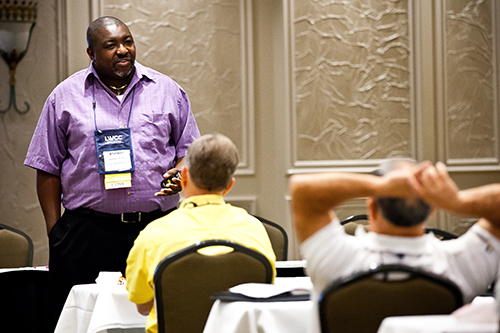Sheldon Primus is the instructor for the Mission of Love Charities (MOLC) Occupational Safety and Health Administration (OSHA) classes for Construction and General Industry. He brings 30 years of experience in hazardous materials and safety and many takeaways to this virtual course.
Primus recently taught the Construction class remotely. The class of MOLC participants offers 10 hours of OSHA training and an additional 10 hours of safety and hazardous materials training to ensure participants receive extra tips on safety to help them on the job.
Primus teaches remotely but one day hopes to teach in person again. For now he uses tools like Chatbox and Airmeet to augment his remote teaching. “Students can mingle before class in a virtual setting,” said Primus, who also encourages them to do speed networking. These tools help teach about hazardous materials found on the job and safety issues encountered there. The upcoming class geared towards General Industry encourages health and wellbeing on many types of jobs – not just construction.
In the OSHA Construction class Primus reviewed the ‘focus four’ safety areas that affect all construction workers. These are the highest killers of workers on the job. Typical hazards in construction are: falls to lower levels, electrocution, struck by or hit with something and being caught in something. The class prepares students for probable safety scenarios which include: workers on a roof without fall protection, walking around and being struck by a crane, walking under a load and being caught underneath that load. Another safety concern for construction workers may be to slip or trip and fall down and hurt themselves on stairs. Machine guarding is also an issue. ”If anything rotates, use a machine guard to protect yourself,” says Primus. He has been an authorized OSHA instructor since 2012 and offers a wealth of knowledge on the topic. Primus hosts a podcast online called Safety Consultant TV, keeping his listeners current on safety issues on the job.
Chemical safety is also quite important to the construction worker, who is exposed to hazardous chemicals regularly. “It’s important to identify hazardous substances by learning to read the safety data sheet on the label first,” said Primus. This skill is taught in class. After learning this, class participants “are more cautious and also more aware of when they’ve been overexposed to the chemicals,” observes Primus.
The takeaways from the OSHA Construction training and General Industries courses are valuable for any worker. The primary takeaway is an OSHA Department of Labor outreach card. “Participants get digital certification and a digital wallet card,” said Primus. In addition to the OSHA certification card class participants receive a 200-page workbook for use in the field. This detailed reference guide was designed by Primus and gives solid information on confronting safety and hazard issues on the job. The workbook applies to many professions.
Primus teaches for other prominent organizations, too. His expertise in hazardous materials and on-the-job safety spans the national arena. Currently Primus teaches for Alliance Safety Council based in Baton Rouge, Louisiana. He also designed a Facility Maintenance class for Florida Gateway College. It was similar to a course taught at University of California Sacramento.
A full 10 hours of training in safety and hazardous materials are required by OSHA to receive certification. Primus added another 10 hours of study to the course. The Mission of Love Charities class is 6 hours, for four days. This includes breaks. Primus added the extra study materials to benefit students who are already working in the field with hazardous materials and safety issues. The additional hours help frame up common scenarios and issues for workers that are critical for wellness and sometimes even life saving.
Primus asks his class participants to do more on the job for safety for themselves and coworkers. “I encourage the class to volunteer for things. Why not be part of safety and health committees as a volunteer part of your job? It’s a practical way to gain understanding of the work atmosphere and how to keep yourself and co-workers safe,” said Primus.
Once a worker is injured on the job, “Safety issues cost companies a great deal of money,” said Primus. It makes far more sense to prevent mishaps by educating the worker what to look out for in the first place. Injuries also cost the worker plenty in money and time lost on the job. “Injuries affect the bottom line,” observed Primus. “Production line workers struggle after a worker is injured. By taking the OSHA class, a participant is doing something for an organization that is protecting the resources,” he added. The worker is also more vigilant about protecting himself and coworkers.
Primus and his wife currently live all over the United States. They travel as part of the Recreational Vehicle (RV) lifestyle. As a hobby, Primus creates and produces electronic music. He is a trained percussionist and loves his pastime.
The course in General Industry will take place from August 30-September 2, 2022, from 9 a.m.- 3 p.m. There is room for enrollment and participants are encouraged to do so well in advance. Visit our events page to sign up for this course.
More News
Greater Baden Medical Services and Mission of Love Charities Partner to Enhance Healthcare and Social Services in Prince George’s County
March 22, 2024
GBMS and MOLC partner to expand health and social services in Prince...
Read moreNewsletter – Issue 1 | 2024
February 1, 2024
Check out the newest edition of the MOLC newsletter!
Read moreJoin the movement “Give Today to Give Hope to Others Tomorrow!
November 28, 2023
This Giving Tuesday, we are urging you to join us in our endeavors by...
Read more